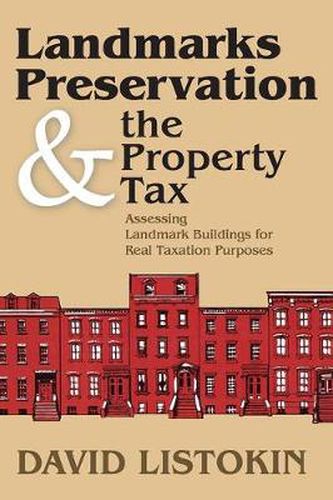Readings Newsletter
Become a Readings Member to make your shopping experience even easier.
Sign in or sign up for free!
You’re not far away from qualifying for FREE standard shipping within Australia
You’ve qualified for FREE standard shipping within Australia
The cart is loading…






Historic preservation is an issue of growing importance and public commitment. Federal and state mechanisms have been established to identify and support historic buildings/sites, while local governments have been active in supporting and protecting historic resources. Communities across the country have established designation programs whereby individual buildings or districts of historical-architectural significance are accorded landmark status. Designation activity has been accompanied by growing interest in other local incentives/disincentives to the support of historic buildings. In this regard, the property tax is viewed as either a possible powerful drawback to or a catalyst of preservation. This study examines the relationship between historic preservation and the property tax, focusing on the question of how designated buildings should be assessed for real taxation purposes. Listokin focuses on New York City in considering the effects of historic status on property value and in evaluating assessment practices. But this book’s findings are transferrable to other communities because the base conditions are similar. Many other cities have designation programs modeled on New York City’s. In addition, New York’s property-tax system and administrative processes resemble those found in communities across the nation. To enhance the transferability of this study’s findings, Listokin refers to the national experience and literature, typically on a side-by-side basis with the New York City counterpart.
$9.00 standard shipping within Australia
FREE standard shipping within Australia for orders over $100.00
Express & International shipping calculated at checkout
Stock availability can be subject to change without notice. We recommend calling the shop or contacting our online team to check availability of low stock items. Please see our Shopping Online page for more details.
Historic preservation is an issue of growing importance and public commitment. Federal and state mechanisms have been established to identify and support historic buildings/sites, while local governments have been active in supporting and protecting historic resources. Communities across the country have established designation programs whereby individual buildings or districts of historical-architectural significance are accorded landmark status. Designation activity has been accompanied by growing interest in other local incentives/disincentives to the support of historic buildings. In this regard, the property tax is viewed as either a possible powerful drawback to or a catalyst of preservation. This study examines the relationship between historic preservation and the property tax, focusing on the question of how designated buildings should be assessed for real taxation purposes. Listokin focuses on New York City in considering the effects of historic status on property value and in evaluating assessment practices. But this book’s findings are transferrable to other communities because the base conditions are similar. Many other cities have designation programs modeled on New York City’s. In addition, New York’s property-tax system and administrative processes resemble those found in communities across the nation. To enhance the transferability of this study’s findings, Listokin refers to the national experience and literature, typically on a side-by-side basis with the New York City counterpart.